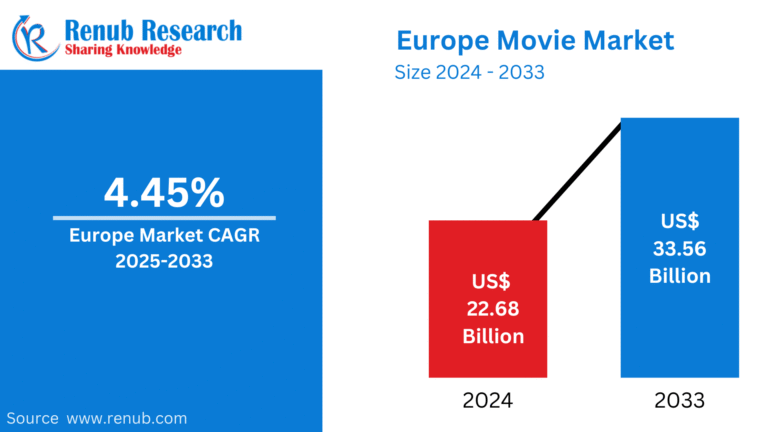Europe Food Cans Market Trends & Forecast (2025-2033)
The Europe Food Cans Market, valued at USD 8.73 billion in 2024, is poised to grow at a steady CAGR of 2.44%, reaching USD 10.82 billion by 2033. This growth is driven by several factors, including an increasing demand for long-shelf-life and convenient food packaging, expanding urbanization, and advancements in sustainable materials. Additionally, the European Union’s regulations promoting green packaging and the shift towards BPA-free cans are further boosting market growth.
Key Drivers of Market Growth:
- Convenience and Long Shelf-Life Foods: With the rise of fast-paced urban lifestyles, consumers are increasingly turning to ready-to-eat and processed foods. The long shelf life and minimal need for refrigeration make food cans an attractive packaging solution. A notable 35% increase in fast-food spending in metropolitan areas from 2022 to 2024 highlights the growing demand for convenient, time-saving food options.
- Sustainability Focus: There is a growing trend toward eco-friendly and BPA-free food cans. With a heightened focus on environmental concerns and increasing regulations on sustainability, consumers are becoming more conscious of their packaging choices, pushing food manufacturers to adopt recyclable and environmentally friendly materials.
- Processed Food Consumption Surge: The demand for processed and packaged food products in Europe is on the rise, with an emphasis on convenience and nutritional value. This is driving the consumption of canned goods, from vegetables and meat to ready meals and pet food.
Challenges in the Market: While the food cans market shows positive growth, challenges such as concerns over BPA and other toxic chemicals in packaging and competition from alternative packaging solutions like flexible pouches and glass jars persist. These challenges may impact market dynamics, but innovations in safer, more sustainable food can technologies are likely to mitigate these risks.
Country-Specific Insights:
- France: France’s food can market is expanding due to a surge in demand for a variety of canned goods, including vegetables and seafood, alongside a strong push for sustainable and BPA-free cans.
- Germany: Germany’s market growth is supported by strict recycling laws and a demand for high-quality, durable canned products. The acquisition of Helvetia Packaging by Crown Holdings in 2023 is a notable development in the region.
- United Kingdom: The UK is witnessing increased demand for healthy and sustainable food cans, driven by a focus on organic and additive-free food products.
New Publish Reports
- Europe Protein Ingredients Market Size and Share Analysis – Growth Trends and Forecast Report 2025-2033
- Europe Respiratory Care Devices Market Size and Share Analysis – Growth Trends and Forecast Report 2025-2033
- Europe Electric Vehicle Market Size and Share Analysis – Growth Trends and Forecast Report 2025-2033
- Europe Neonatal Intensive Care Market Size and Share Analysis – Growth Trends and Forecast Report 2025-2033
Product Segments:
- Aluminum Cans: Widely used for soups, vegetables, seafood, and ready meals due to their lightweight and recyclability.
- Steel Cans: Preferred for canned pet food and meat products due to their strength and ability to provide excellent barrier protection.
Application Segments:
- Ready Meals
- Meat & Vegetables
- Fish & Seafood
- Pet Food & Others
Future Outlook: The Europe Food Cans Market is expected to experience robust growth due to rising consumer preference for convenient, sustainable food packaging, supported by regulatory initiatives and growing eco-consciousness. Innovations in food preservation, along with the continuous rise in processed food consumption, will likely fuel the demand for food cans throughout the region.
For more detailed insights and customization, feel free to reach out to our analysts.
FAQs: Europe Food Cans Market
- What is the current size of the Europe Food Cans Market?
- The market is valued at USD 8.73 billion in 2024 and is expected to reach USD 10.82 billion by 2033, growing at a CAGR of 2.44%.
- What factors are driving the demand for food cans in Europe?
- Key drivers include the increasing demand for convenient, long-shelf-life foods, urbanization, eco-friendly packaging, and growth in ready-to-eat meals.
- How do eco-friendly and BPA-free cans influence the market?
- Environmental concerns and regulations promoting recyclable packaging have led consumers and manufacturers to favor BPA-free, eco-friendly food cans, boosting market growth.
- Which countries are expected to lead in market growth?
- Countries such as France, Germany, and the United Kingdom are expected to contribute significantly due to strong consumer demand and sustainable packaging trends.
- What challenges does the Europe Food Cans Market face?
- Challenges include concerns about toxic coatings like BPA and competition from alternative packaging solutions, such as flexible pouches and glass jars.
- What is the market share of aluminum versus steel cans?
- Aluminum cans dominate the market due to their recyclability and lightweight nature, while steel cans are primarily used for pet food and meat due to their strength.
- How significant is the demand for processed food in this market?
- The demand for processed and packaged foods is a key driver of the food cans market, particularly in urban areas, where convenience is highly valued.
- How do consumer preferences for organic and preservative-free products impact the market?
- The rise in health-conscious consumers opting for organic and preservative-free canned goods has led manufacturers to innovate and provide healthier product offerings.









